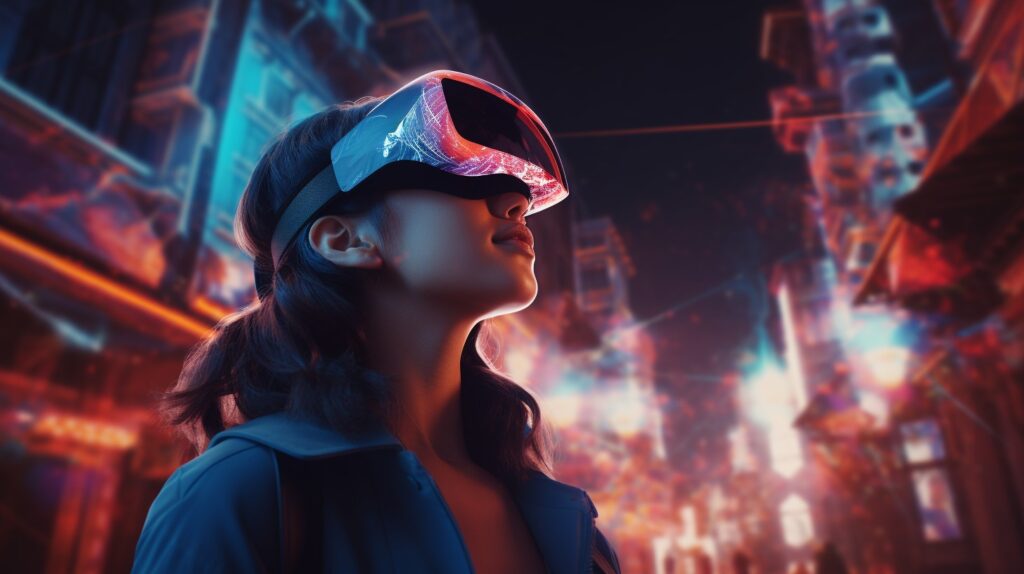Exploring the Exciting World of the AR Metaverse

Step into the magnificent world of limitless possibilities, where reality intertwines seamlessly with imagination. Welcome to the AR metaverse, the brave new frontier that holds the key to unlocking an entirely groundbreaking era for gaming and entertainment as we know it. In this blog post, we will dive headfirst into a mesmerizing journey through time and space, exploring why you should be excited about what lies ahead. So fasten your seatbelts and prepare for a mind-bending expedition that will leave you in awe of how technology is reshaping our perception of reality itself. Are you ready to embrace the future? Let’s embark on this thrilling adventure together.
Introduction to AR Metaverse: What is it and why is it gaining popularity in the gaming and entertainment industry?
Augmented Reality (AR) has been making significant strides in the gaming and entertainment industry, with the emergence of the AR metaverse. This futuristic concept is rapidly gaining popularity, offering a completely new dimension to how we experience games and other forms of entertainment. In this section, we will delve into what exactly an AR metaverse is and why it is creating such excitement in the gaming and entertainment world.
The term “metaverse” was first coined by Neal Stephenson in his 1992 science-fiction novel Snow Crash. It refers to a collective virtual shared space, created by the convergence of multiple online virtual worlds or augmented reality environments that are becoming more interconnected over time. The concept of a metaverse can be described as a persistent, rich immersive digital environment that exists beyond physical limitations.
Adding an augmented reality layer to this definition takes it to another level altogether. AR technology allows digital information to be overlaid on real-world environments through the use of smart devices such as smartphones or AR headsets like Microsoft HoloLens. An AR metaverse would then be an interconnected network of these augmented realities where users can interact with each other and with digital content in real-time.
One of the main reasons for the rising popularity of an AR metaverse in the gaming and entertainment industry is its ability to offer an unprecedented level of immersion and interactivity. With advances in technology, developers are now able to create highly realistic virtual experiences that seamlessly blend with the real world. This opens up endless possibilities for gaming and entertainment, providing a truly unique and personalized experience for users.
Moreover, an AR metaverse breaks down the physical barriers of traditional gaming and entertainment by allowing users to access these virtual experiences from anywhere. This means players can engage in immersive games or interact with digital characters in their own home, at a park, or even while traveling – all through their mobile devices or AR headsets.
Furthermore, an AR metaverse encourages social interaction and collaboration among players. By creating a shared digital space where multiple users can interact and engage in activities together, it brings a new level of socialization to gaming and entertainment.
Future Potential
The potential of an AR metaverse extends far beyond just gaming and entertainment. It has the power to revolutionize industries such as education, healthcare, retail, and advertising. For example, imagine attending a virtual classroom where students from different parts of the world can learn together in an immersive environment. Or having access to real-time medical assistance through AR technology during emergencies.
The possibilities are endless, and as technology continues to advance, we can expect to see more developments in this exciting concept of an augmented reality metaverse. Overall, the rise of AR metaverse is expected to transform the way we perceive and interact with digital content, blurring the lines between the virtual and real world.
The Technology Behind AR Metaverse
The concept of a virtual metaverse, where users can enter and engage in a fully immersive augmented reality (AR) experience, was once thought to only exist in science fiction. However, recent advancements in AR technology have made this idea not only possible but also an exciting potential for the future of gaming and entertainment. In this section, we will dive into the specific technologies that have enabled the development of the AR metaverse.
It all starts with augmented reality – a technology that overlays digital information onto our real-world environment. Unlike virtual reality (VR), which completely immerses us in a computer-generated world, AR blends virtual elements with our physical surroundings, creating a seamless merging of the two.
One of the key technological developments that have propelled AR forward is improved hardware. With more powerful processors and advanced graphics capabilities on our devices such as smartphones and tablets, AR experiences are becoming increasingly realistic and immersive. This has allowed for smoother tracking and rendering of virtual objects within our environment, making it easier for users to suspend disbelief and fully immerse themselves in the experience.
Another crucial component behind the AR metaverse is spatial mapping technology. This is what allows our devices to understand and interpret our physical surroundings accurately. Through sensors like cameras, depth scanners, and lidar systems, spatial mapping captures real-time data about our environment’s size, shape, depth, lighting conditions, etc. This information is then used to create accurate 3D maps or models that are essential for placing virtual objects seamlessly into our surroundings within the metaverse.
In the AR metaverse, real-world objects can be digitally enhanced or replaced with virtual ones, making it crucial for these virtual objects to interact realistically with the physical world. This is where physics engines come into play. These software libraries simulate real-world physics, allowing virtual objects to behave like they would in our physical world. For example, a virtual ball can bounce off a real wall or a digital character can walk on top of a real table.
Another critical aspect that enables social interaction within the AR metaverse is networking technology. Just like how we communicate and interact with each other in the physical world, users need to be connected in the virtual world as well. This is achieved through network protocols.
Sources:
– Neal Stephenson, Snow Crash
– Microsoft HoloLens




Source link
#Exploring #Exciting #World #Metaverse





